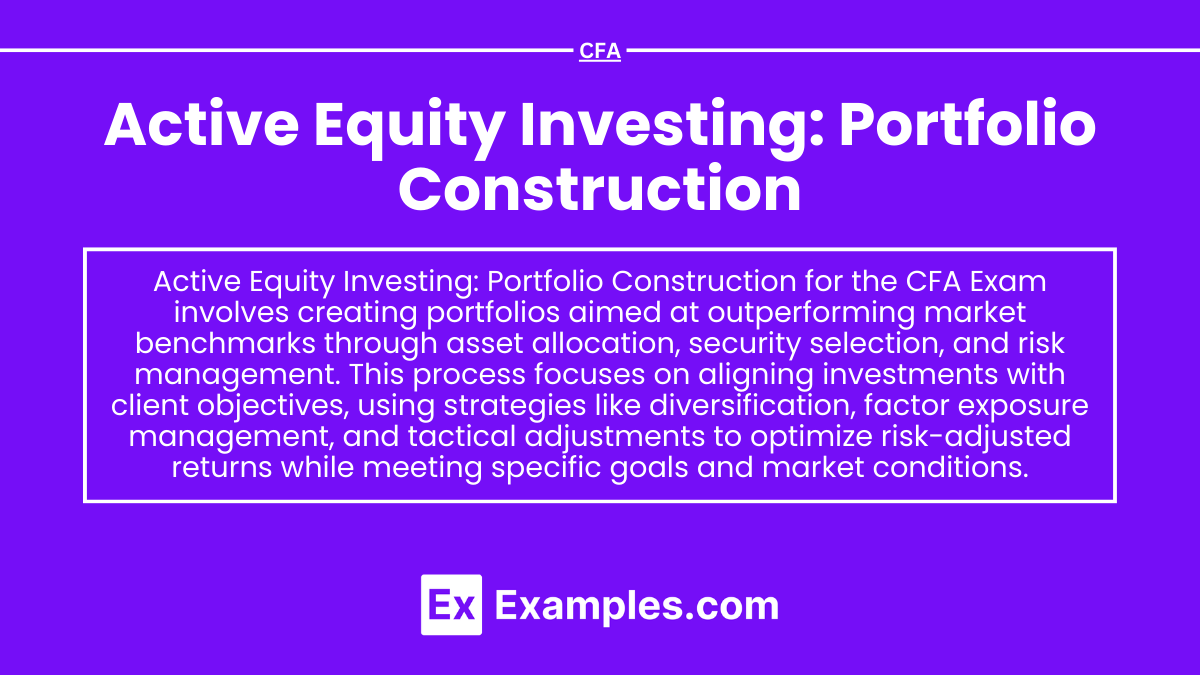Preparing for the CFA Exam requires a comprehensive understanding of Active Equity Investing: Portfolio Construction, a vital component of equity management. Mastery of asset allocation, security selection, diversification, and risk management is essential. This knowledge aids in building portfolios tailored to client objectives, optimizing returns, and managing market risks for superior performance.
Learning Objective
In studying “Active Equity Investing: Portfolio Construction” for the CFA Exam, you should learn to construct equity portfolios using active strategies that align with client objectives and risk tolerance. Analyze the principles of asset allocation, security selection, and diversification to build portfolios aimed at outperforming market benchmarks. Evaluate approaches for risk management, factor exposures, and liquidity constraints. Additionally, explore methods to optimize portfolio returns through tactical adjustments, fundamental and quantitative analysis, and performance measurement. Apply this understanding to real-world scenarios and CFA practice questions, focusing on constructing high-performing equity portfolios tailored to diverse client needs.
Asset Allocation and Security Selection
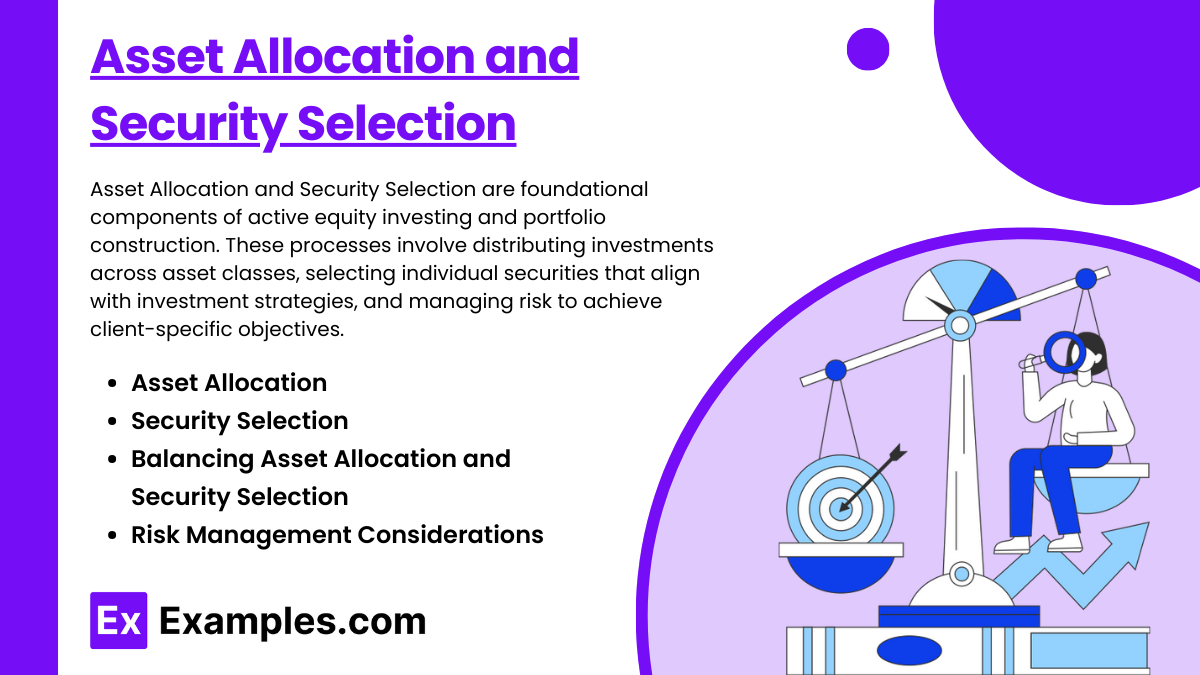
Asset Allocation and Security Selection are foundational components of active equity investing and portfolio construction. These processes involve distributing investments across asset classes, selecting individual securities that align with investment strategies, and managing risk to achieve client-specific objectives. Here’s a detailed explanation of these key elements:
1. Asset Allocation:
Asset allocation is the process of determining the optimal distribution of an investor’s capital across different asset classes (e.g., equities, fixed income, cash) based on their goals, risk tolerance, and time horizon. It can be categorized into two main types:
- Strategic Asset Allocation: This involves setting long-term asset mix targets based on a client’s objectives and risk profile. For example, a growth-oriented client may have a higher allocation to equities, while a more conservative investor may have a greater allocation to bonds. Strategic allocation seeks to provide a balanced portfolio that achieves long-term goals, regardless of short-term market fluctuations.
- Tactical Asset Allocation: This approach involves making short-term adjustments to the asset mix to take advantage of market conditions, economic trends, or anticipated shifts. For example, a manager may increase exposure to equities during an anticipated market rally or reduce risk during a downturn by shifting to defensive assets. Tactical allocation aims to enhance returns and manage risk within the strategic allocation framework.
2. Security Selection:
Security selection is the process of choosing individual investments within a specific asset class to meet the portfolio’s objectives. This step is critical in active equity investing, as it aims to generate alpha (excess returns above a benchmark). Managers use various methods to identify securities with high potential:
- Fundamental Analysis: Evaluating a company’s financial health, including its earnings, cash flows, growth prospects, industry position, and competitive advantages. This approach seeks to identify undervalued or overvalued stocks based on intrinsic value.
- Technical Analysis: Analyzing historical price and volume data to identify patterns, trends, and potential future movements. This method helps managers time their trades based on market behavior.
- Quantitative Analysis: Using mathematical and statistical models to identify patterns, correlations, and predictive factors that drive stock performance. This data-driven approach leverages algorithms and big data to optimize security selection.
- Top-Down vs. Bottom-Up Approaches:
- Top-Down Approach: Focuses on macroeconomic trends, industry dynamics, and sector-specific analysis before selecting individual securities. For example, if the economy is expanding, a manager might prioritize sectors expected to benefit from growth, like technology or consumer discretionary.
- Bottom-Up Approach: Concentrates on analyzing individual securities regardless of macroeconomic trends. Managers focus on a company’s fundamentals, such as earnings potential, management quality, and valuation metrics, to determine investment suitability.
3. Balancing Asset Allocation and Security Selection:
Effective portfolio construction requires aligning asset allocation and security selection with client objectives and market conditions. While asset allocation sets the overall risk and return framework, security selection determines how well individual investments perform within that framework. Active managers must continuously monitor market trends, macroeconomic indicators, and client needs to make adjustments.
4. Risk Management Considerations:
Both asset allocation and security selection must be aligned with risk management practices to ensure that the portfolio remains within acceptable risk parameters. Diversification, hedging strategies, and periodic rebalancing help manage portfolio risk and optimize performance.
Diversification and Factor Exposure
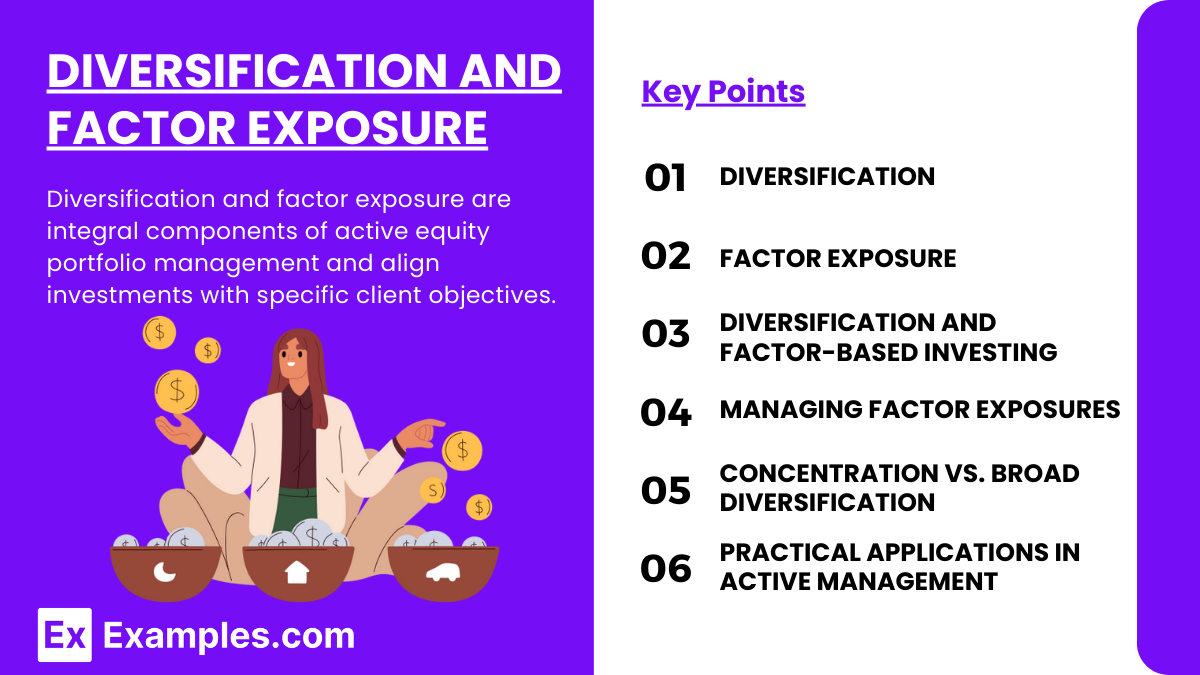
Diversification and factor exposure are integral components of active equity portfolio management, helping to manage risk, enhance returns, and align investments with specific client objectives. Here’s a detailed explanation of these concepts:
1. Diversification:
Diversification is a risk management strategy that involves spreading investments across various asset classes, sectors, industries, or geographic regions to reduce exposure to any single security or market segment. The rationale is that by holding a broad mix of investments, the negative performance of one asset or sector can be offset by the positive performance of others, thereby reducing overall portfolio risk.
Key Elements of Diversification Include:
- Asset Class Diversification: Allocating funds among different asset classes such as equities, fixed income, commodities, and alternative investments to spread risk.
- Sector and Industry Diversification: Investing in a range of sectors (e.g., technology, healthcare, consumer goods) to avoid excessive exposure to a single industry’s performance.
- Geographic Diversification: Gaining exposure to different regions and markets, such as domestic and international markets, to reduce country-specific risk.
- Individual Security Diversification: Holding a variety of securities within each asset class to minimize the impact of poor performance from any one security.
The primary goal of diversification is to minimize unsystematic risk, which is the risk specific to individual companies or industries, while maintaining exposure to systematic (market) risk that affects all assets.
2. Factor Exposure:
Factor exposure involves identifying and managing a portfolio’s sensitivity to certain factors or drivers of returns, which can systematically influence asset performance. Factor-based investing focuses on tilting the portfolio towards factors believed to provide excess returns over time. Common factors include:
- Market Factor (Beta): Exposure to overall market risk, represented by beta. Portfolios with a higher beta are more sensitive to market movements, while lower-beta portfolios are less sensitive.
- Size Factor: Small-cap stocks have historically provided higher returns, albeit with greater risk, compared to large-cap stocks. Managers may adjust exposure based on their view of market conditions.
- Value Factor: Value stocks (those trading at low prices relative to their fundamentals) often generate excess returns over growth stocks. Value factor exposure involves tilting portfolios toward undervalued securities.
- Momentum Factor: Stocks with strong recent performance often continue to perform well in the short term. Momentum investing capitalizes on this trend.
- Quality Factor: High-quality stocks, characterized by strong balance sheets, consistent earnings, and good governance, often outperform lower-quality counterparts.
- Volatility Factor: Some investors may prefer low-volatility stocks, which tend to exhibit more stable performance compared to high-volatility stocks.
3. Diversification and Factor-Based Investing:
Effective portfolio construction involves combining diversification with factor-based investing to optimize risk-adjusted returns. By diversifying across factors, active managers can reduce concentration risk and target factors that historically drive excess returns.
4. Managing Factor Exposures:
Active managers must carefully monitor and adjust factor exposures to align with market conditions and client objectives. This involves:
- Overweighting or Underweighting Factors: Depending on market trends, a manager may tilt the portfolio towards factors expected to outperform (e.g., increasing exposure to value stocks during market recoveries).
- Risk Management: Managing factor exposure helps mitigate risks such as concentration risk, style drift, and unintended exposure to certain market dynamics.
5. Concentration vs. Broad Diversification:
While broad diversification helps reduce risk, concentrated bets on specific factors or sectors can enhance alpha generation if well-executed. However, this approach increases risk and may lead to greater volatility.
6. Practical Applications in Active Management:
- Customized Portfolios: Active managers may create customized portfolios to align with client objectives, risk tolerance, and preferred factor exposures (e.g., ESG factors).
- Performance Attribution: Factor analysis helps managers attribute performance to specific factors, allowing for a better understanding of what drives returns and whether the portfolio’s risk exposures align with client goals.
Risk Management and Liquidity Considerations
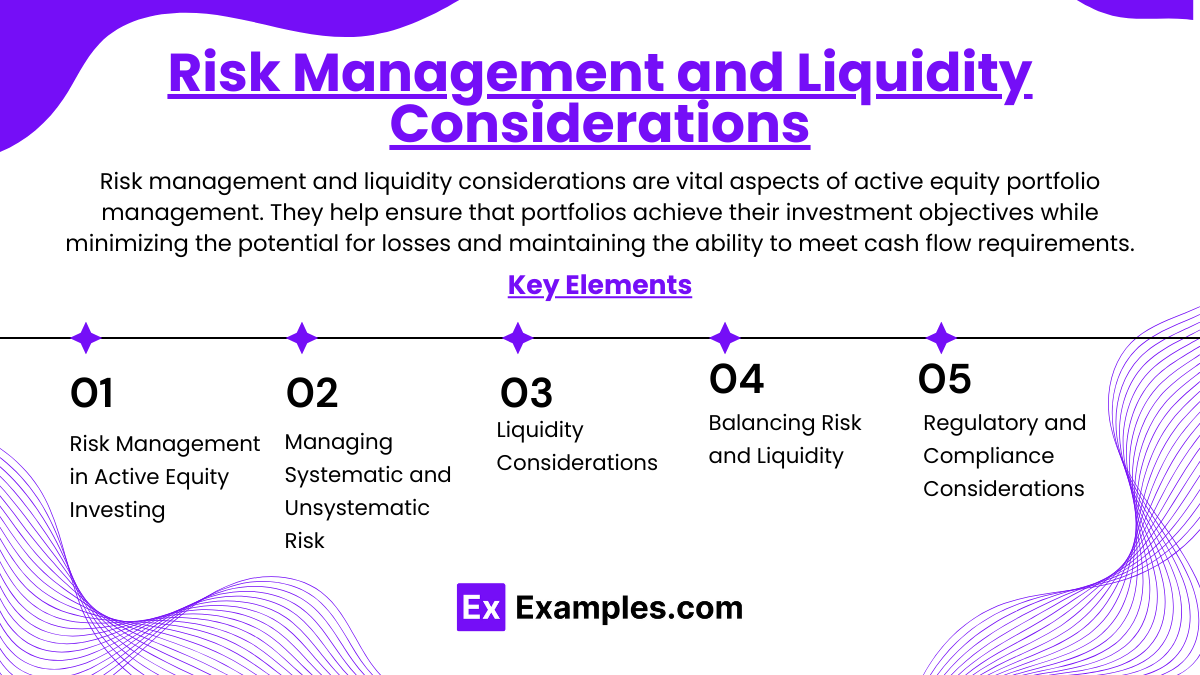
Risk management and liquidity considerations are vital aspects of active equity portfolio management. They help ensure that portfolios achieve their investment objectives while minimizing the potential for losses and maintaining the ability to meet cash flow requirements. Here’s a detailed explanation of these concepts:
1. Risk Management in Active Equity Investing:
Risk management involves identifying, assessing, and mitigating the risks associated with investing in equities. Active managers strive to balance the pursuit of returns with the need to control risk exposure in order to meet client objectives and maintain portfolio stability.
- Risk Measurement Techniques: Managers use various tools to measure risk, including:
- Beta: A measure of a portfolio’s sensitivity to market movements. Higher beta indicates greater volatility relative to the market.
- Standard Deviation: Indicates the variability of returns and serves as a measure of total risk.
- Value-at-Risk (VaR): Estimates the potential loss in value of a portfolio over a specific time frame at a given confidence level.
- Stress Testing and Scenario Analysis: Evaluating portfolio performance under extreme market conditions to assess potential downside risks.
- Diversification as a Risk Management Tool: Spreading investments across different asset classes, sectors, or geographies reduces the impact of poor performance in any one area and lowers unsystematic risk.
- Hedging Strategies: Managers may use derivatives (options, futures) or short positions to hedge against market downturns or mitigate specific risks within the portfolio.
- Position Sizing and Stop-Loss Orders: Limiting the size of individual holdings and using stop-loss orders to automatically sell securities if they decline to a certain price can help control losses.
2. Managing Systematic and Unsystematic Risk:
- Systematic Risk (Market Risk): This is the risk inherent to the entire market and cannot be eliminated through diversification. Active managers seek to manage this risk by adjusting the portfolio’s overall exposure based on market conditions (e.g., reducing equity exposure during economic downturns).
- Unsystematic Risk (Specific Risk): This risk is unique to individual securities or industries and can be mitigated through diversification and careful security selection.
3. Liquidity Considerations:
Liquidity refers to the ability to quickly buy or sell assets in the market without significantly affecting their prices. Liquidity is a key consideration for active equity managers, as it influences trading costs, portfolio flexibility, and the ability to meet client needs.
- Market Liquidity: The ease with which securities can be traded in the market. Highly liquid stocks can be bought or sold quickly with minimal price impact, whereas illiquid stocks may require longer trading times and larger spreads.
- Client Liquidity Needs: Some clients may have specific liquidity requirements, such as the need to withdraw funds for expenses or meet cash flow obligations. Managers must structure portfolios to ensure sufficient liquid assets are available to meet these needs without disrupting the overall strategy.
- Liquidity Risk Management: To mitigate liquidity risk, managers may:
- Hold a Portion of Liquid Assets: Keeping a portion of the portfolio in highly liquid assets like cash or large-cap stocks provides flexibility to meet unexpected cash needs.
- Monitor Market Conditions: Understanding market liquidity trends helps avoid trading during periods of low liquidity, which can lead to higher transaction costs and market impact.
- Avoid Overconcentration in Illiquid Assets: Investing heavily in small-cap stocks or niche markets with limited trading volume can expose the portfolio to liquidity risk.
4. Balancing Risk and Liquidity:
Active managers must strike a balance between pursuing high returns and maintaining adequate liquidity to manage risks and meet client obligations. For example, a manager may pursue higher returns through small-cap or illiquid securities but maintain a portion of the portfolio in liquid, low-risk assets to ensure overall stability.
5. Regulatory and Compliance Considerations:
Many active managers are subject to regulations that dictate risk management and liquidity practices. Ensuring compliance with regulatory requirements and client mandates is a critical component of effective portfolio management.
6. Practical Applications of Risk and Liquidity Management:
Active managers continuously monitor market and portfolio conditions, making adjustments as needed to align with risk and liquidity objectives. For example, in times of market stress, managers may reduce exposure to high-risk assets or increase cash holdings to maintain liquidity and stability.
Portfolio Optimization and Performance Evaluation
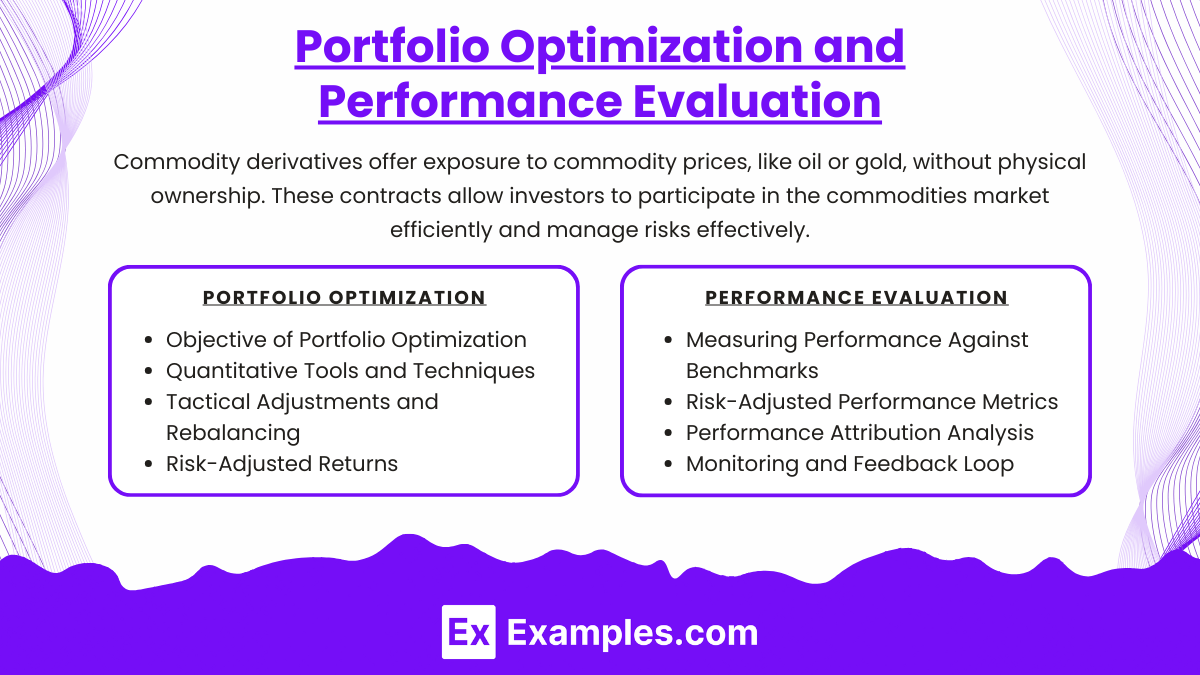
Portfolio optimization and performance evaluation are critical processes in active equity portfolio management. They ensure that portfolios are structured to achieve maximum returns for a given level of risk while continuously assessing performance to ensure alignment with investment objectives. Here’s an in-depth explanation of these key concepts:
Portfolio Optimization
1. Objective of Portfolio Optimization:
Portfolio optimization involves constructing a portfolio that offers the best possible expected return for a given level of risk or minimizes risk for a given expected return. This process is guided by principles of modern portfolio theory (MPT) and aims to create an efficient frontier—a set of portfolios that provides the highest returns at each level of risk.
2. Quantitative Tools and Techniques:
- Mean-Variance Optimization: This technique, introduced by Harry Markowitz, seeks to balance the trade-off between risk and return by calculating expected returns, variances, and covariances of the securities in the portfolio. The goal is to identify the optimal allocation that minimizes risk for a target level of expected return.
- Constraints and Customization: Optimization models often include constraints such as asset class weights, sector allocations, liquidity needs, or regulatory requirements to ensure the portfolio aligns with specific client needs.
- Factor-Based Optimization: This approach involves targeting specific factor exposures (e.g., value, size, momentum) based on historical evidence of excess returns. Managers may tilt the portfolio to emphasize factors that are expected to outperform in the future.
- Scenario Analysis and Stress Testing: Testing the portfolio under different market scenarios (e.g., market crashes, interest rate changes) helps evaluate how resilient the portfolio is to adverse conditions.
3. Tactical Adjustments and Rebalancing:
Active portfolio managers frequently adjust allocations to respond to changes in market conditions, economic indicators, or client needs. This process is called rebalancing and ensures that the portfolio remains aligned with its target asset allocation, risk levels, and strategic objectives. Tactical adjustments can include increasing exposure to high-growth sectors, reducing holdings in overvalued securities, or shifting geographical focus based on macroeconomic trends.
4. Risk-Adjusted Returns:
Optimized portfolios aim to achieve high risk-adjusted returns, meaning returns that are attractive relative to the level of risk taken. Metrics such as the Sharpe ratio (return per unit of risk) or the Sortino ratio (downside risk-adjusted return) are often used to evaluate portfolio efficiency.
Performance Evaluation
1. Measuring Performance Against Benchmarks:
Performance evaluation involves assessing the portfolio’s returns relative to a relevant benchmark or index. This comparison helps determine whether the manager’s active strategies are adding value or simply replicating market performance. Key considerations include:
- Absolute Returns: The total returns generated by the portfolio without reference to a benchmark.
- Relative Returns: Returns relative to a benchmark, such as a market index. Positive relative returns indicate outperformance, while negative relative returns suggest underperformance.
2. Risk-Adjusted Performance Metrics:
- Sharpe Ratio: Measures excess return per unit of risk (volatility). A higher Sharpe ratio indicates better risk-adjusted performance.
- Information Ratio: Compares the portfolio’s excess return to its tracking error, indicating the consistency of returns relative to a benchmark.
- Alpha: Represents the excess return generated by the portfolio relative to the expected return based on its risk (beta). Positive alpha indicates outperformance due to the manager’s skill.
3. Performance Attribution Analysis:
Performance attribution breaks down the sources of excess return to help managers understand where value is being added. This analysis typically covers:
- Asset Allocation Effect: The impact of allocating more or less capital to specific asset classes, sectors, or regions compared to the benchmark.
- Security Selection Effect: Evaluates the performance of individual securities relative to their benchmark counterparts.
- Interaction Effect: Measures the combined impact of asset allocation and security selection decisions on overall performance.
4. Monitoring and Feedback Loop:
Continuous monitoring of performance and feedback allows active managers to refine their strategies and make adjustments as needed. This process ensures alignment with client goals and helps identify areas for improvement.
5. Client Communication and Reporting:
Clear communication of performance results, including risk-adjusted returns and attribution analysis, is crucial for maintaining client trust and transparency. Reports should highlight how the portfolio has performed relative to its objectives and benchmarks and explain the factors contributing to success or underperformance.
Examples
Example 1: Strategic Asset Allocation with Tactical Adjustments
A portfolio manager sets a long-term allocation of 70% equities and 30% bonds based on a client’s growth-oriented goals and risk tolerance. During periods of anticipated market expansion, the manager tactically shifts an additional 10% into equities, focusing on growth sectors to enhance returns, while rebalancing when market conditions change.
Example 2: Diversified Global Equity Portfolio
An active manager constructs a global equity portfolio that includes investments in multiple regions, such as North America, Europe, Asia, and emerging markets. The portfolio is further diversified across sectors, such as technology, healthcare, and consumer goods, reducing exposure to country-specific risks and improving overall risk-adjusted returns.
Example 3: Factor-Based Portfolio Construction
A portfolio manager employs a factor-based strategy by tilting the portfolio towards value and momentum factors. By overweighting undervalued stocks with positive momentum, the manager aims to achieve alpha while managing risk through diversified sector exposure and periodic adjustments based on market conditions.
Example 4: Bottom-Up Security Selection with Fundamental Analysis
A manager adopts a bottom-up approach, selecting individual stocks based on detailed analysis of company fundamentals, such as earnings growth, competitive advantages, and cash flow generation. The resulting portfolio focuses on high-conviction positions in companies with strong financials, regardless of macroeconomic or sector-specific trends.
Example 5: Liquidity-Conscious Portfolio Construction
To meet a client’s liquidity needs, a manager constructs a portfolio with a mix of liquid large-cap stocks and a small allocation to less liquid small-cap stocks. The manager actively monitors market liquidity and maintains sufficient cash or near-cash holdings to address any potential client withdrawals or portfolio rebalancing needs.
Practice Questions
Question 1:
Which of the following is a primary objective of portfolio optimization in active equity investing?
A) Replicating market returns with minimal cost
B) Constructing a portfolio with the highest possible returns, regardless of risk
C) Maximizing expected returns for a given level of risk
D) Avoiding all exposure to market fluctuations
Answer: C) Maximizing expected returns for a given level of risk
Explanation:
Portfolio optimization seeks to balance risk and return, creating a portfolio that offers the highest possible expected returns for a given level of risk or minimizes risk for a target return. This approach aligns with modern portfolio theory, distinguishing it from simply replicating market returns or focusing solely on risk avoidance.
Question 2:
An active equity manager decides to overweight technology stocks based on anticipated industry growth. This is an example of:
A) Diversification
B) Sector Rotation
C) Factor-Based Investing
D) Passive Indexing
Answer: B) Sector Rotation
Explanation:
Sector rotation involves shifting portfolio allocations toward specific sectors expected to outperform based on economic trends, market conditions, or industry developments. In this example, the manager’s decision to overweight technology stocks aligns with anticipated growth, reflecting a tactical shift to capture potential gains.
Question 3:
A portfolio manager constructs a diversified equity portfolio by selecting securities based on their fundamental financial health. This approach is best described as:
A) Top-Down Approach
B) Quantitative Analysis
C) Bottom-Up Approach
D) Technical Analysis
Answer: C) Bottom-Up Approach
Explanation:
The bottom-up approach focuses on analyzing individual companies’ fundamentals, such as financial statements, earnings growth, and competitive position, rather than starting with macroeconomic or sector-wide trends. This method emphasizes the selection of high-conviction securities based on detailed analysis, independent of broader market movements.

